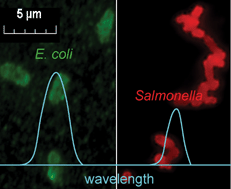In this study, we explored the use of semiconductor quantum dots (QDs) as fluorescence labels in immunoassays for simultaneous detection of two species of foodborne pathogenic bacteria, Escherichia coli O157∶H7 and Salmonella Typhimurium. QDs with different sizes can be excited with a single wavelength of light, resulting in different emission peaks that can be measured simultaneously. Highly fluorescent semiconductor quantum dots with different emission wavelengths (525 nm and 705 nm) were conjugated to anti-E. coli O157 and anti-Salmonella antibodies, respectively. Target bacteria were separated from samples by using specific antibody coated magnetic beads. The bead–cell complexes reacted with QD–antibody conjugates to form bead–cell–QD complexes. Fluorescent microscopic images of QD labeled E. coli and Salmonella cells demonstrated that QD–antibody conjugates could evenly and completely attach to the surface of bacterial cells, indicating that the conjugated QD molecules still retain their effective fluorescence, while the conjugated antibody molecules remain active and are able to recognize their specific target bacteria in a complex mixture. The intensities of fluorescence emission peaks at 525 nm and 705 nm of the final complexes were measured for quantitative detection of E. coli O157∶H7 and S. Typhimurium simultaneously. The fluorescence intensity (FI) as a function of cell number (N) was found for Salmonella and E. coli, respectively. The regression models can be expressed as: FI = 60.6log N
− 250.9 with R2 = 0.97 for S. Typhimurium, and FI = 77.8log N
− 245.2 with R2 = 0.91 for E. coli O157∶H7 in the range of cell numbers from 104 to 107 cfu ml−1. The detection limit of this method was 104 cfu ml−1. The detection could be completed within 2 hours. The principle of this method could be extended to detect multiple species of bacteria (3–4 species) simultaneously, depending on the availability of each type of QD–antibody conjugates with a unique emission peak and the antibody coated magnetic beads specific to each species of bacteria.

You have access to this article
 Please wait while we load your content...
Something went wrong. Try again?
Please wait while we load your content...
Something went wrong. Try again?


 Please wait while we load your content...
Please wait while we load your content...